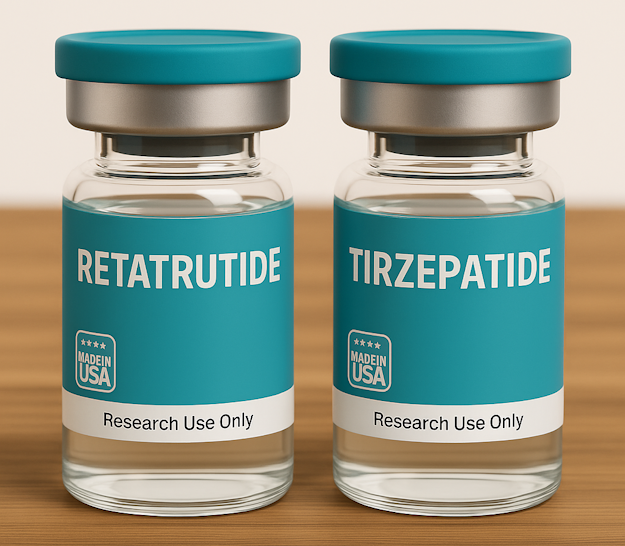In the world of treating obesity and related chronic conditions, two medications have gained significant attention: Retatrutide and Tirzepatide. Both drugs are designed to promote weight loss, improve blood sugar control, and support overall metabolic health, but they differ in structure, mechanisms, and clinical outcomes. To learn more about verified suppliers, you can buy Retatrutide peptide online from trusted research sources. Comparing these 2 peptides helps patients, clinicians, and researchers understand which therapy might be best suited for weight management and diabetes care.
Recent clinical trials have provided insight into the efficacy and effectiveness of these innovative treatments. Eli Lilly, a leading pharmaceutical company, developed both drugs as part of their ongoing commitment to combating obesity and improving glycemic control in patients with type 2 diabetes and related conditions. Researchers can also view our Retatrutide for sale overview for sourcing details.
Understanding the Mechanisms of Each
The key differences between these two medications lie in how they interact with the body’s hormonal pathways. Tirzepatide is a dual agonist, meaning it targets two receptors: the GLP-1 receptor and GIP receptors. GLP-1 (glucagon-like peptide-1) and GIP (glucose-dependent insulinotropic polypeptide) work together to suppress appetite, reduce hunger, and regulate blood sugar levels. This glp 1 and gip combination helps obese patients and those with type 2 diabetes lose weight while improving insulin sensitivity.
Retatrutide, on the other hand, is a triple agonist. It stimulates GLP-1, GIP, and glucagon receptors. This triple action offers a more comprehensive approach to weight reduction, as the inclusion of the glucagon receptor agonist pathway can enhance energy use and fat metabolism. As a result, both peptides are effective, but Retatrutide may have a slight edge in helping people lose more weight in a shorter timeframe.
Related Article – Retatrutide vs Semaglutide Comparison
Clinical Trials and Research
Extensive randomized controlled trials and double-blind studies have been conducted to evaluate the efficacy of Retatrutide and Tirzepatide. Published data in the New England Journal and other respected journals show promising results for both drugs. Ongoing research and ongoing studies continue to provide more data on safety and long-term outcomes.
For Retatrutide, early findings from the phase studies suggest greater weight loss outcomes due to its comprehensive approach. In one parallel group trial, participants experienced a greater weight loss compared to those receiving Tirzepatide, showing that the triple action mechanism may offer superior benefits.
Tirzepatide, which is already FDA approved for certain uses under a recognizable brand name, has been widely adopted for diabetes treatment and diabetes management. It has a proven track record of helping patients manage blood sugar, achieve significant weight loss, and improve metabolic health.
Weight Loss Outcomes
Both Tirzepatide and Retatrutide are designed to support weight loss, but early studies indicate that Retatrutide could deliver greater weight loss. While Tirzepatide has been shown to help patients achieve an average weight loss of up to 20% of their body weight, Retatrutide targets multiple pathways, potentially leading to greater weight loss compared to dual-agonist drugs.
The exact numbers vary depending on the trial design, dosage, and participant characteristics. Systematic review and meta-analysis research are ongoing to determine the most effective dosing strategies and identify which medications are best suited for chronic weight management.
See our handy Retatrutide dosage chart to learn more about the dosing schedule for both men and women based on weight category.
Side Effects and Safety Considerations
Like all treatment options for obesity, these drugs come with potential side effects. Common side effects include nausea, diarrhea, and gastrointestinal discomfort. Rarely, obstructive sleep apnea symptoms may worsen temporarily due to rapid changes in body weight. Safety data from clinical trials suggest that while both drugs are generally well-tolerated, monitoring is essential, especially in patients with pre-existing chronic conditions.
Proper preparation and mixing are covered in our guide on how to reconstitute Retatrutide.
Side-by-Side Comparison Table
| Retatrutide | Tirzepatide | |
|---|---|---|
| Mechanism | Triple agonist targeting GLP-1, GIP, and glucagon receptors for a more comprehensive approach to weight reduction and energy use | Dual agonist targeting GLP-1 and GIP receptors to suppress appetite and regulate blood sugar |
| Weight Loss Results | Early clinical trials show greater weight loss potential, with some patients exceeding 24% reduction in body weight | Proven average weight loss around 15-20% of body weight |
| Side Effects | Similar to other GLP-1 drugs: nausea, diarrhea, possible worsening of obstructive sleep apnea symptoms | Similar side effects, with well-documented safety profile from FDA approved use |
| Dosages | Still under study in ongoing research; not yet commercially approved | Standardized dosages available under brand name for diabetes care and weight management |
| Benefits | May offer a slight edge in helping people lose weight quickly and improve metabolic health | Effective for blood sugar control, weight loss journey, and diabetes management |
FDA Approval and Availability
One major difference in the discussion of these 2 peptides is regulatory status. Tirzepatide is FDA approved and available under a well-known brand name, making it accessible for treatment of type 2 diabetes and weight management in certain patients. It has undergone extensive testing and meets stringent safety and efficacy standards.
Retatrutide, however, remains in the early phases of testing; see our Retatrutide legal status and FDA process for current regulatory details. It is not yet approved for commercial use, but early studies and ongoing research indicate it could become a highly effective option once more data are available. The FDA will require additional clinical trials before making a final decision.
The Role of GLP-1 and GIP in Weight Management
The success of both drugs stems from their ability to influence natural hormones like GLP-1 and GIP. These compounds are essential for regulating appetite, blood sugar, and energy use. When combined, as in glp 1 and gip receptor stimulation, they suppress appetite, reduce hunger, and encourage the body to burn fat more efficiently.
Adding the glucagon-like peptide 1 and glucagon receptor agonist pathways, as seen with Retatrutide, provides a more comprehensive approach to weight reduction. This triple action could revolutionize the future of weight management and diabetes care.
Frequently Asked Questions
Does Retatrutide work immediately?
No, Retatrutide does not work immediately. Like other GLP-1 and GIP based medications, it takes several weeks for the body to adjust and begin showing noticeable results. Early clinical trials indicate that some patients may experience a reduction in appetite and blood sugar levels within the first few weeks, but significant weight loss generally occurs over several months. This is similar to what was noted in the clinical studies of each peptide, where gradual progress was observed rather than instant changes.
What is another name for Retatrutide?
As of now, this peptide does not have a widely recognized brand name because it has not yet been FDA approved for commercial use. It is currently referred to only by its research name in ongoing studies and phase trials. Once Eli Lilly completes testing and receives regulatory approval, a branded version will likely be introduced, similar to how Tirzepatide is marketed under a specific brand name.
Why is the FDA stopping Tirzepatide?
The FDA is not stopping Tirzepatide altogether. Instead, they sometimes issue warnings or temporary holds on certain batches or treatment uses to ensure safety and compliance. These actions are common during the monitoring of any approved drug, especially those used for chronic weight management and diabetes care.
Currently, Tirzepatide remains FDA approved for weight loss and diabetes treatment, and there is no indication that the agency plans to completely discontinue its use. Such safety checks are part of normal regulatory oversight to protect patients.
Is Retatrutide worth it?
For many people, Retatrutide may prove to be worth it, but only once it becomes approved and widely available. Early clinical trials show promising results, with some participants experiencing greater weight loss compared to Tirzepatide. Because it acts as a triple agonist, targeting GLP-1, GIP, and glucagon receptors, it offers a more comprehensive approach to weight reduction, blood sugar control, and overall metabolic health.
However, until more data from randomized controlled trials are published and FDA approval is granted, this peptide should be considered experimental. It shows great potential, especially for obese patients with chronic conditions, but further research is essential before making a final judgment.
Conclusion
When comparing these 2 peptides, both drugs represent groundbreaking advancements in treatment for obesity and related conditions. Tirzepatide is already widely used, offering proven results in weight loss and blood sugar control. Retatrutide, while still under investigation, shows potential to be even more highly effective thanks to its triple action targeting multiple hormonal pathways.
As ongoing studies continue and more data emerge, the choice between these two medications will become clearer. For now, Tirzepatide remains the leading option for those seeking to lose weight and improve glycemic control, while Retatrutide offers hope for a future with even greater weight loss and a comprehensive approach to treating obesity.
Researchers interested in exploring this compound further can buy Retatrutide peptide online for approved laboratory studies.
Ultimately, the decision should be made with the guidance of healthcare professionals who can evaluate individual needs, chronic conditions, and long-term health goals.

